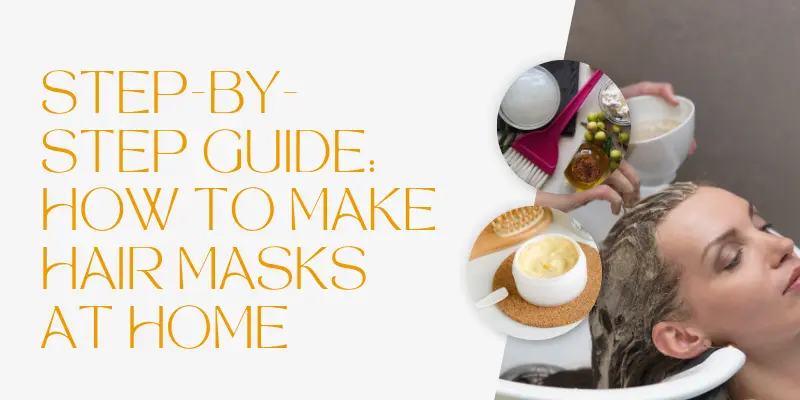How to Make Hair Masks at Home – Easy DIY Recipes to Transform Your Locks
Published: 26 Mar 2025
Ever wish you could achieve salon-worthy hair without breaking the bank? The good news is you can! If you’re wondering how to make hair masks at home, it’s easier than you might think. Using simple, natural ingredients like avocado, honey, and yogurt, you can create DIY hair masks that transform your hair from dull to dazzling all in the comfort of your kitchen.
Why Make Hair Masks at Home?
DIY hair masks are affordable, easy to make, and free from harsh chemicals. Plus, they can be tailored to suit your unique hair needs, whether it’s dryness, oiliness, or breakage.
Essential Ingredients for Homemade Hair Masks
The best part about DIY hair masks? You don’t need fancy products. Many hair-nourishing ingredients may already be sitting in your pantry!

Here are some must-have ingredients and what they do for your hair:
- Avocado – Deeply hydrates and nourishes dry hair.
- Honey – Locks in moisture and adds shine.
- Yogurt – Cleanses the scalp and strengthens hair.
- Coconut Oil – Repairs damaged hair and prevents split ends.
- Lemon Juice – Balances scalp oil and fights dandruff.
- Eggs – Boosts protein for stronger, healthier hair.
Step-by-Step Guide: How to Make Hair Masks at Home
Create nourishing hair masks at home using simple ingredients like eggs, honey, yogurt, or oils.

This step-by-step guide helps you customize treatments to repair damage and regrow thinning hair naturally.
1. For Dry, Damaged Hair
For dry, damaged hair, hydration and repair should be your top priorities. Using nourishing oils and moisture-rich treatments can help restore softness, strength, and shine.
Ingredients:
- ½ ripe avocado
- 1 tablespoon honey
- 1 tablespoon coconut oil
How to Use:
- Mash the avocado until smooth.
- Mix in the honey and coconut oil.
- Apply the mask from roots to ends.
- Leave it on for 20 minutes, then rinse with lukewarm water.
Why It Works: This mask adds moisture, repairs damage, and leaves your hair soft and shiny.
2. For Oily Scalp and Hair
For oily scalp and hair, focus on balancing sebum production without stripping essential moisture. Lightweight, clarifying treatments can help keep your hair fresh, clean, and healthy.
Ingredients:
- 2 tablespoons yogurt
- 1 tablespoon lemon juice
How to Use:
- Mix the yogurt and lemon juice until well combined.
- Please apply to your scalp and let it sit for 15 minutes.
- Rinse thoroughly with cool water.
Why It Works: Yogurt cleanses excess oil, while lemon juice balances scalp pH and controls greasiness.
3. For Hair Growth and Strength
For hair growth and strength, nourish your scalp with nutrient-rich ingredients that stimulate follicles. Strengthening treatments help reduce breakage and promote thicker, healthier strands.
Ingredients:
- 1 egg
- 1 tablespoon olive oil
How to Use:
- Beat the egg and mix in the olive oil.
- Apply the mixture evenly to your hair.
- Leave it on for 20 minutes, then rinse with cold water (to avoid “cooked egg” hair!).
Why It Works: The egg boosts protein, while olive oil strengthens and smooths hair strands.
How Often Should You Use Hair Masks?
Most hair types benefit from a weekly treatment, but extremely dry or damaged hair may need 2–3 sessions for optimal results.

Consistency is key to getting the best results. Here’s a quick guide:
- Dry, damaged hair: Use a mask 2–3 times a week.
- Oily hair: Once a week is enough.
- Normal hair: Every other week to maintain healthy locks.
Avoid overusing it, as excessive product can cause buildup.
Real-Life Examples: Tried-and-Tested Recipes
Here are some real users who swear by DIY hair masks:
- Maya, 27: “The avocado and coconut oil mask brought my dull, dry hair back to life in just a few weeks!”
- Jake, 34: “The yogurt and lemon juice mask helped control my oily scalp and reduced my dandruff.”
- Aisha, 19: “After using the egg and olive oil mask, my hair feels thicker and stronger.”
Common Mistakes to Avoid
When making and using hair masks, keep these tips in mind:
- Don’t apply too much: A little goes a long way.
- Avoid hot water rinses: Always use lukewarm or cool water to rinse out masks.
- Test for allergies: Try a patch test if you’re using a new ingredient.
- Mix fresh: DIY masks work best when made fresh, so avoid storing leftovers.
Conclusion
Hair care doesn’t have to be expensive or complicated. With just a few ingredients and a little time, you can give your locks the love they deserve. Now that you know how to make hair masks at home, go ahead, mix up a mask, put on your favorite playlist, and treat yourself to some self-care magic!
FAQs: Your Top Hair Mask Questions Answered
Moisturizing masks help add water and softness to your hair. Strengthening masks give your hair more protein to reduce breakage. If your hair feels dry and rough, pick a moisturizer. If it feels weak or snaps easily, go for strengthening.
No, because oily and dry hair need different care. Oily hair works best with light ingredients like lemon or yogurt. Dry hair needs richer oils like coconut or argan. Using the wrong mask can make your hair problem worse.
Not always, because too much protein can make hair stiff. They are best for damaged, bleached, or weak hair. Healthy or fine hair might feel heavy with protein masks. Always balance protein masks with moisturizing ones.
Yes, clay masks are great for oily hair and scalps. They absorb extra oil and clean out dirt from the roots. They also leave the scalp feeling fresh and light. Use once a week to avoid drying out your hair.
Store-bought masks are quick and easy to use. DIY masks are natural, affordable, and chemical-free.
Both can work well depending on your needs. Choose what fits your time, budget, and preference.
Yes, masks can keep dyed hair soft and shiny. Pick ones with gentle oils like coconut or olive.
Avoid harsh chemicals that can fade your color. Use weekly to keep your color looking fresh.
Yes, they work in different ways. Leave-in masks stay in your hair for all-day care. Rinse-out masks are washed away after a short time. Choose based on how much time you have and your needs.
Overnight masks stay on your hair while you sleep. They give your hair deep hydration and repair.
Perfect for very dry or damaged hair types. Use a towel on your pillow to avoid a mess.
Yes, they can make masks work even better. Heat opens up your hair so nutrients go deeper.
Good for very dry or thick hair types. Skip them if you have a sensitive scalp.
It’s better to use one mask at a time. Mixing too many can cause product buildup.
It can also make ingredients work against each other. Alternate masks weekly for the best results.

- Be Respectful
- Stay Relevant
- Stay Positive
- True Feedback
- Encourage Discussion
- Avoid Spamming
- No Fake News
- Don't Copy-Paste
- No Personal Attacks



- Be Respectful
- Stay Relevant
- Stay Positive
- True Feedback
- Encourage Discussion
- Avoid Spamming
- No Fake News
- Don't Copy-Paste
- No Personal Attacks

![Regrow Thinning Hair- Proven Ways Men Can Get Fuller Hair [Dermatologist-Approved] - Post Thumbnail](https://naturalhaircares.com/wp-content/uploads/10-Proven-Ways-to-Regrow-Thinning-Hair-100x67.webp)



